AMD’s 5 GHz Turbo CPU in Retail: The FX-9590 and ASRock 990FX Extreme9 Review
by Ian Cutress on August 9, 2014 8:00 AM ESTCPU Benchmarks: Comparing the AMD FX-9590
The dynamics of CPU Turbo modes, both Intel and AMD, can cause concern during environments with a variable threaded workload. There is also an added issue of the motherboard remaining consistent, depending on how the motherboard manufacturer wants to add in their own boosting technologies over the ones that Intel would prefer they used. In order to remain consistent, we implement an OS-level unique high performance mode on all the CPUs we test which should override any motherboard manufacturer performance mode.
It is worth noting that the FX-9590, against the A10-7850K for example, has double the threads and +1 GHz of core speed, despite the generational gap. Considering only these factors, the FX-9590 is most likely similar if not better at single threaded performance, but also 2x for multithreaded results.
HandBrake v0.9.9: link
For HandBrake, we take two videos (a 2h20 640x266 DVD rip and a 10min double UHD 3840x4320 animation short) and convert them to x264 format in an MP4 container. Results are given in terms of the frames per second processed, and HandBrake uses as many threads as possible.
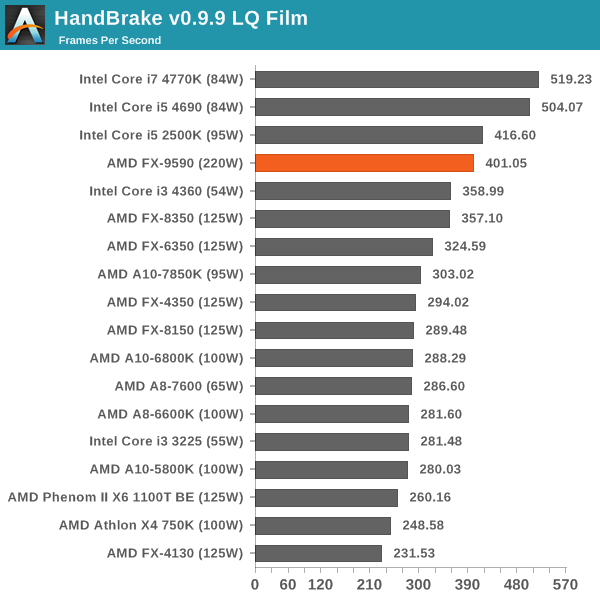
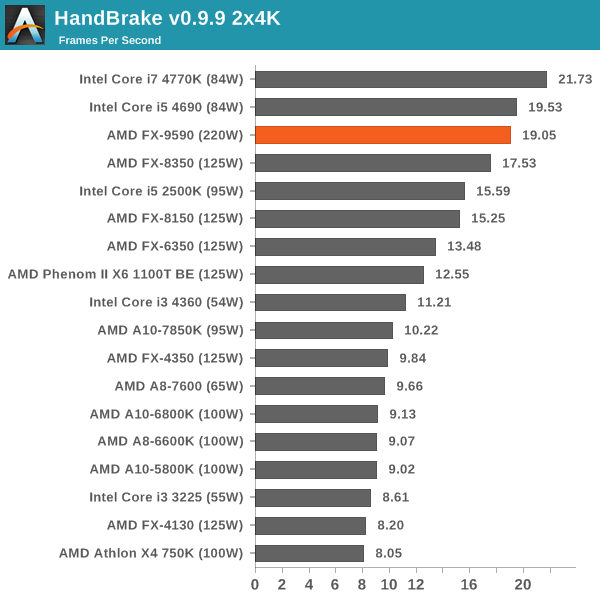
The eight threads of the FX-9590 give it almost another third of performance over the A10-7850K for small frame videos and nearly 2x for the larger frame conversion.
Agisoft Photoscan – 2D to 3D Image Manipulation: link
Agisoft Photoscan creates 3D models from 2D images, a process which is very computationally expensive. The algorithm is split into four distinct phases, and different phases of the model reconstruction require either fast memory, fast IPC, more cores, or even OpenCL compute devices to hand. Agisoft supplied us with a special version of the software to script the process, where we take 50 images of a stately home and convert it into a medium quality model. This benchmark typically takes around 15-20 minutes on a high end PC on the CPU alone, with GPUs reducing the time.
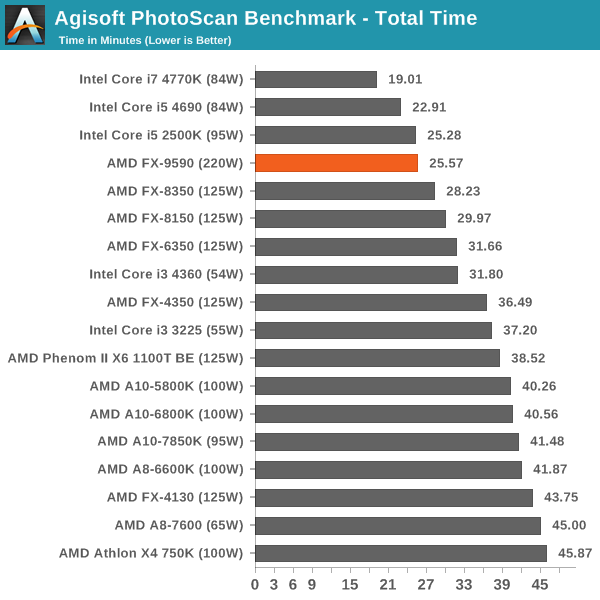
The FX-9590 puts in the best AMD CPU performance, similar to that of the i5-2500K.
Dolphin Benchmark: link
Many emulators are often bound by single thread CPU performance, and general reports tended to suggest that Haswell provided a significant boost to emulator performance. This benchmark runs a Wii program that raytraces a complex 3D scene inside the Dolphin Wii emulator. Performance on this benchmark is a good proxy of the speed of Dolphin CPU emulation, which is an intensive single core task using most aspects of a CPU. Results are given in minutes, where the Wii itself scores 17.53 minutes.
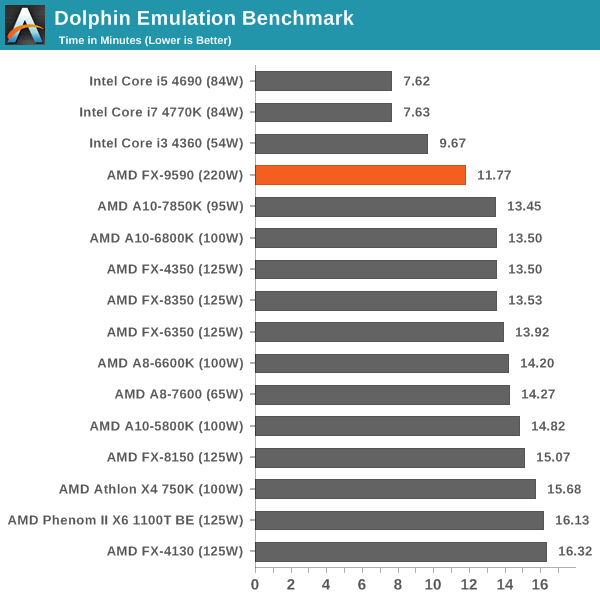
The FX-9590 beats almost everything pre-Haswell, showing the strength of a 5.0 GHz turbo mode. Note that it compares to the 3.5 GHz, 4MB L3 cache Haswell, which is 1.5 GHz slower and has half the L3.
WinRAR 5.0.1: link
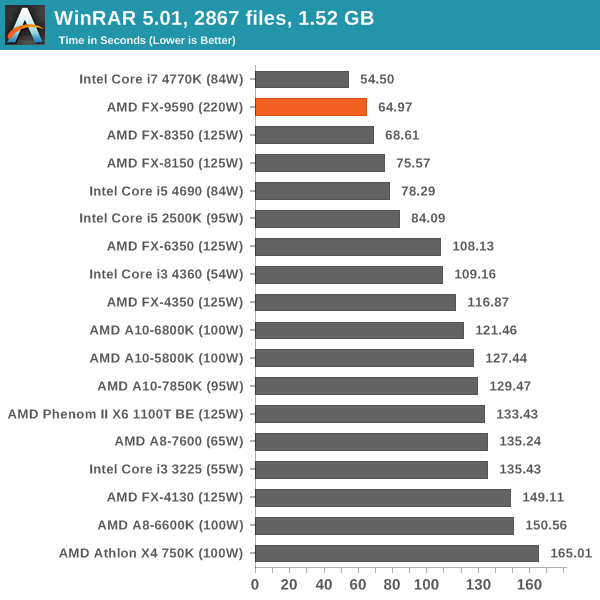
PCMark8 v2 OpenCL on R7 240
A new addition to our CPU testing suite is PCMark8 v2, where we test the Work 2.0 and Creative 3.0 suites in OpenCL mode.
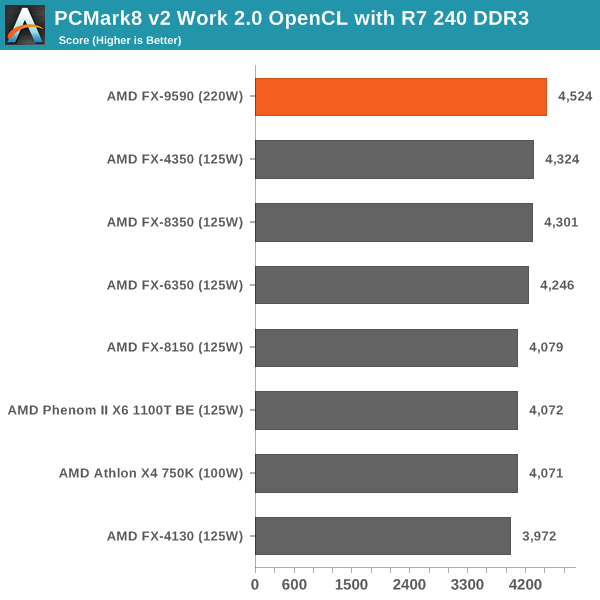
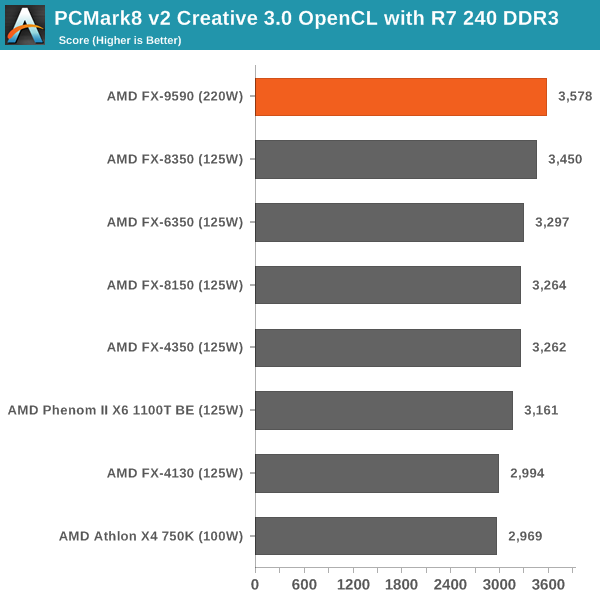
Hybrid x265
Hybrid is a new benchmark, where we take a 4K 1500 frame video and convert it into an x265 format without audio. Results are given in frames per second.
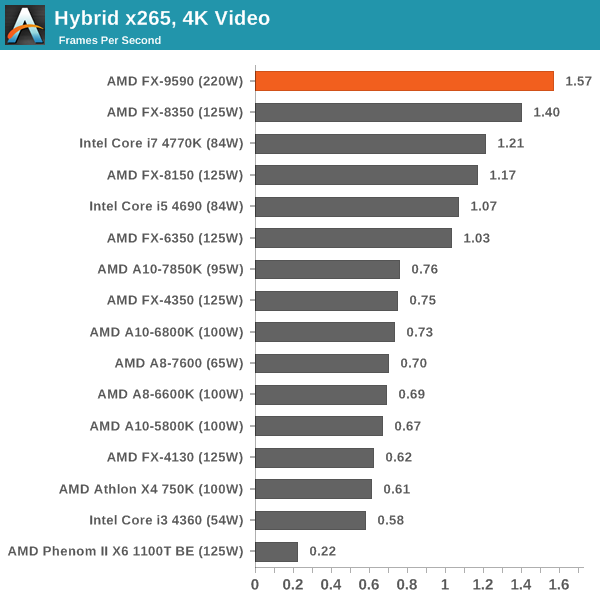
The FX-9590 holds up very well in the Hybrid x265 conversion, which makes me wonder how well an 8-thread Kaveri CPU would perform.
Cinebench R15
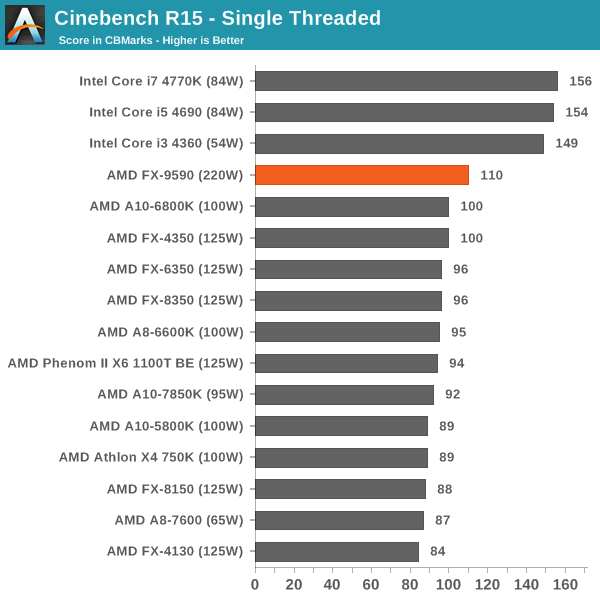
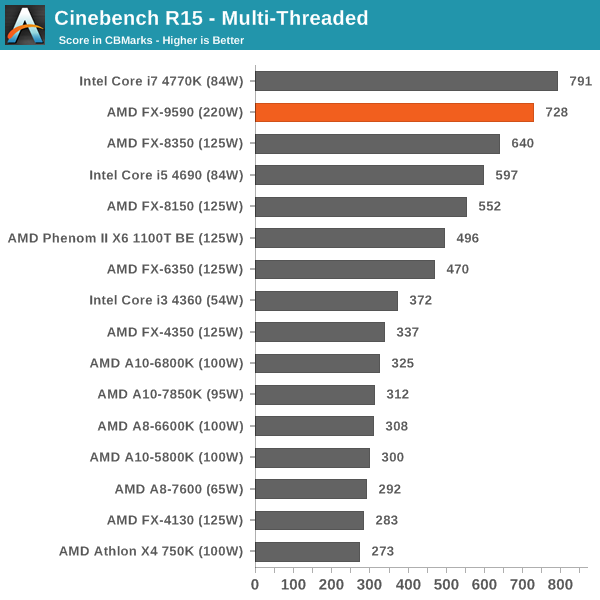
The FX-9590 still has the single thread edge over the newer AMD CPUs due to the high frequency, but is easily overtaken by the modern cheap Intel CPUs. For multithreaded competition, the 8 threads needs an 8 threaded Intel CPU to compete.
3D Particle Movement
3DPM is a self-penned benchmark, taking basic 3D movement algorithms used in Brownian Motion simulations and testing them for speed. High floating point performance, MHz and IPC wins in the single thread version, whereas the multithread version has to handle the threads and loves more cores.
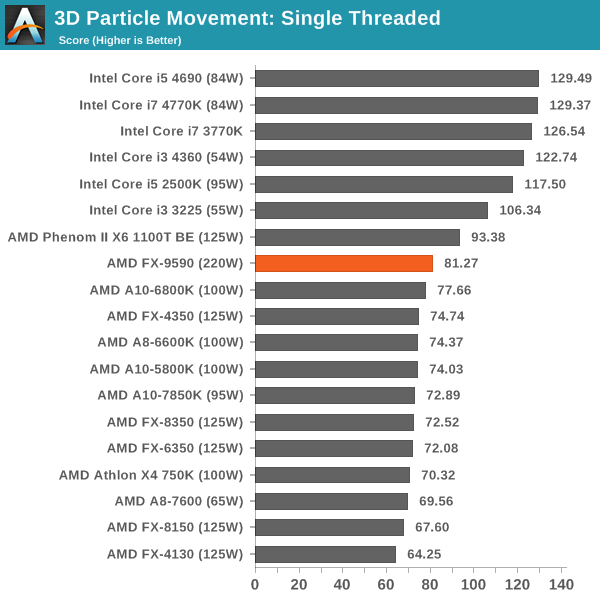
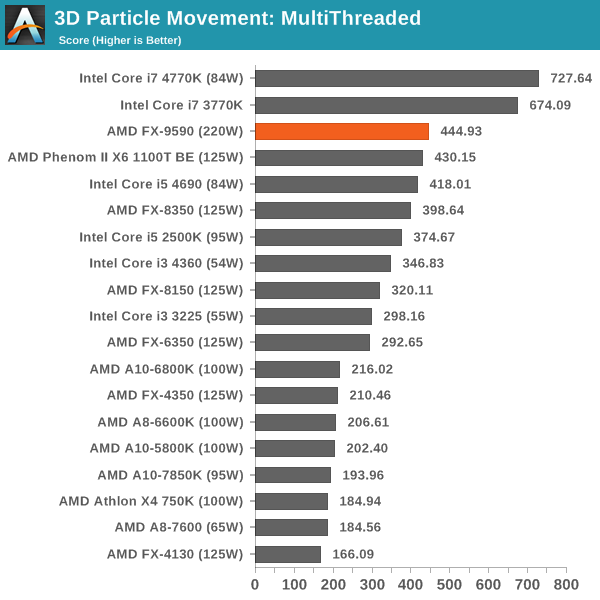
Although the FX-9590 again performs as the best AMD CPU, the floating point nature of the calculations in this test seems not to be favored by this architecture.
FastStone Image Viewer 4.9
FastStone is the program I use to perform quick or bulk actions on images, such as resizing, adjusting for color and cropping. In our test we take a series of 170 images in various sizes and formats and convert them all into 640x480 .gif files, maintaining the aspect ratio. FastStone does not use multithreading for this test, and results are given in seconds.

Similarly to 3DPM, for basic photo conversion any base 3.2 GHz Haswell CPU can outperform a 5.0 GHz AMD.










146 Comments
View All Comments
Budburnicus - Wednesday, January 14, 2015 - link
+1 EXACTLY my point! People KEEP bringing up fab sizes, but it is a simple TRUTH that a 3 year old 32 nm SandyBridge is FAR faster in nearly every conceivable way - at STOCK speeds no less!Apply a 4.7 GHz overclock (as my SandyBridge system has ) - and the Per Clock (as well as gaming performance!) actually BEATS my Haswell i7-5930K (which with the same Cooler Master Hyper 212 EVO w/dual fans - is at a stable 4.4 Ghz) - in gaming!
Budburnicus - Wednesday, January 14, 2015 - link
*per CORE* - not clock (same IPC obviously)roadapathy - Monday, August 11, 2014 - link
In fact, I argued this point on my Steam Gamers group page and some said I was not fully understanding. I'll laugh a little about that because I talked with an employee of Intel at my work and he has a PhD in electrical engineering from Purdue. He said that I was correct and that the lithography makes a huge differences in power and performance of a CPU. Even if AMD CPUs/APUs are slower per IPC, it still does the job and it still costs much less to produce an entire PC system.Budburnicus - Wednesday, January 14, 2015 - link
Fab size isn't the problem here! A 3 year old i5-2500K or i7-2600K is built with a 32 nm fab and is only a 95 watt TDP part! On top of that, it is QUITE easy to overclock either to 4.7 GHz - and even then the power draw is at least 1/3 less and the CPU will be MUCH faster in EVERY way!Hell, at STOCK speeds, an i7-2600K is faster!
LarsBars - Saturday, August 9, 2014 - link
I wanted to build a Hyper-V lab for my work, so I ended up going with AMD FX. I don't care about overcook and the power consumption argument to me is not a big deal. I got my 8350 and 8320 on sale, and for the number of threads, the cache, and the hardware virtualization support, it was one of the cheapest ways to put together two 32 GB lab servers.Sttm - Saturday, August 9, 2014 - link
So this a fanboy only product? Not sure how anyone else can believe its a better purchase over an i7. Slower in most things, similar cost, multiple times the power usage.TiGr1982 - Saturday, August 9, 2014 - link
Well, for the unbiased customer there is indeed no sense in going with this FX rather than with i7.So, AFAIU, this is indeed a product for die-hard AMD fans. The only problem is that the number of these people is diminishing from year to year, I suppose.
darkich - Saturday, August 9, 2014 - link
What a terrible product.A 220W CPU now days?
Facepalm
gostan - Saturday, August 9, 2014 - link
I know AT team needs to eat. It's just painful to see them try so hard to be easy on AMD.darkich - Sunday, August 10, 2014 - link
+1